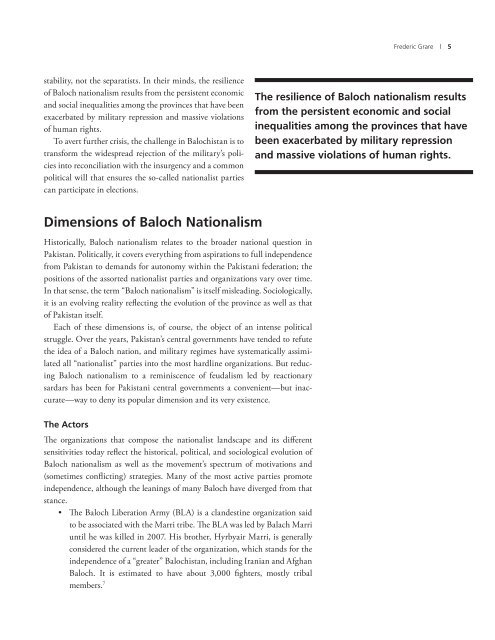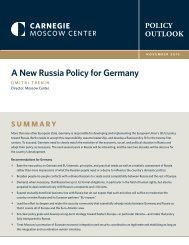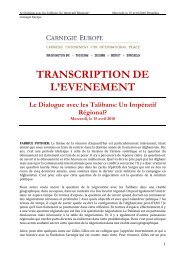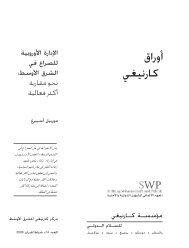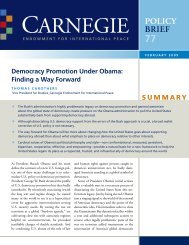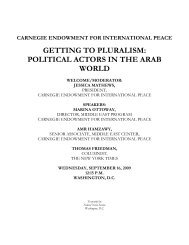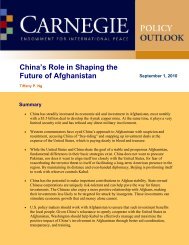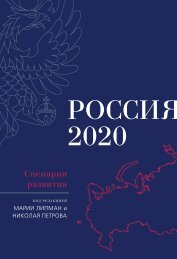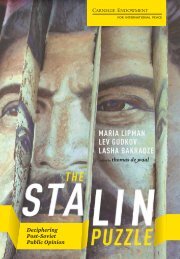BALOCHISTAN - Carnegie Endowment for International Peace
BALOCHISTAN - Carnegie Endowment for International Peace
BALOCHISTAN - Carnegie Endowment for International Peace
You also want an ePaper? Increase the reach of your titles
YUMPU automatically turns print PDFs into web optimized ePapers that Google loves.
stability, not the separatists. In their minds, the resilience<br />
of Baloch nationalism results from the persistent economic<br />
and social inequalities among the provinces that have been<br />
exacerbated by military repression and massive violations<br />
of human rights.<br />
To avert further crisis, the challenge in Balochistan is to<br />
trans<strong>for</strong>m the widespread rejection of the military’s policies<br />
into reconciliation with the insurgency and a common<br />
political will that ensures the so-called nationalist parties<br />
can participate in elections.<br />
Dimensions of Baloch Nationalism<br />
Historically, Baloch nationalism relates to the broader national question in<br />
Pakistan. Politically, it covers everything from aspirations to full independence<br />
from Pakistan to demands <strong>for</strong> autonomy within the Pakistani federation; the<br />
positions of the assorted nationalist parties and organizations vary over time.<br />
In that sense, the term “Baloch nationalism” is itself misleading. Sociologically,<br />
it is an evolving reality reflecting the evolution of the province as well as that<br />
of Pakistan itself.<br />
Each of these dimensions is, of course, the object of an intense political<br />
struggle. Over the years, Pakistan’s central governments have tended to refute<br />
the idea of a Baloch nation, and military regimes have systematically assimilated<br />
all “nationalist” parties into the most hardline organizations. But reducing<br />
Baloch nationalism to a reminiscence of feudalism led by reactionary<br />
sardars has been <strong>for</strong> Pakistani central governments a convenient—but inaccurate—way<br />
to deny its popular dimension and its very existence.<br />
The Actors<br />
The organizations that compose the nationalist landscape and its different<br />
sensitivities today reflect the historical, political, and sociological evolution of<br />
Baloch nationalism as well as the movement’s spectrum of motivations and<br />
(sometimes conflicting) strategies. Many of the most active parties promote<br />
independence, although the leanings of many Baloch have diverged from that<br />
stance.<br />
• The Baloch Liberation Army (BLA) is a clandestine organization said<br />
to be associated with the Marri tribe. The BLA was led by Balach Marri<br />
until he was killed in 2007. His brother, Hyrbyair Marri, is generally<br />
considered the current leader of the organization, which stands <strong>for</strong> the<br />
independence of a “greater” Balochistan, including Iranian and Afghan<br />
Baloch. It is estimated to have about 3,000 fighters, mostly tribal<br />
members. 7<br />
Frederic Grare | 5<br />
The resilience of Baloch nationalism results<br />
from the persistent economic and social<br />
inequalities among the provinces that have<br />
been exacerbated by military repression<br />
and massive violations of human rights.


